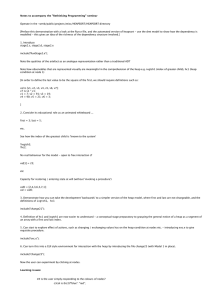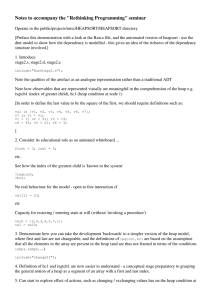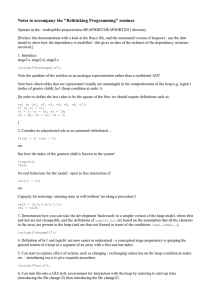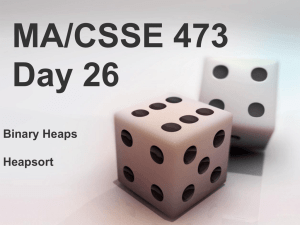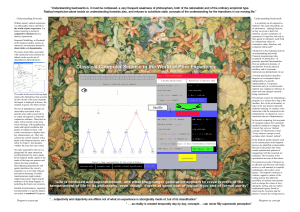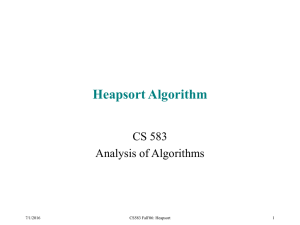Notes to accompany the "Rethinking Programming" seminar
advertisement
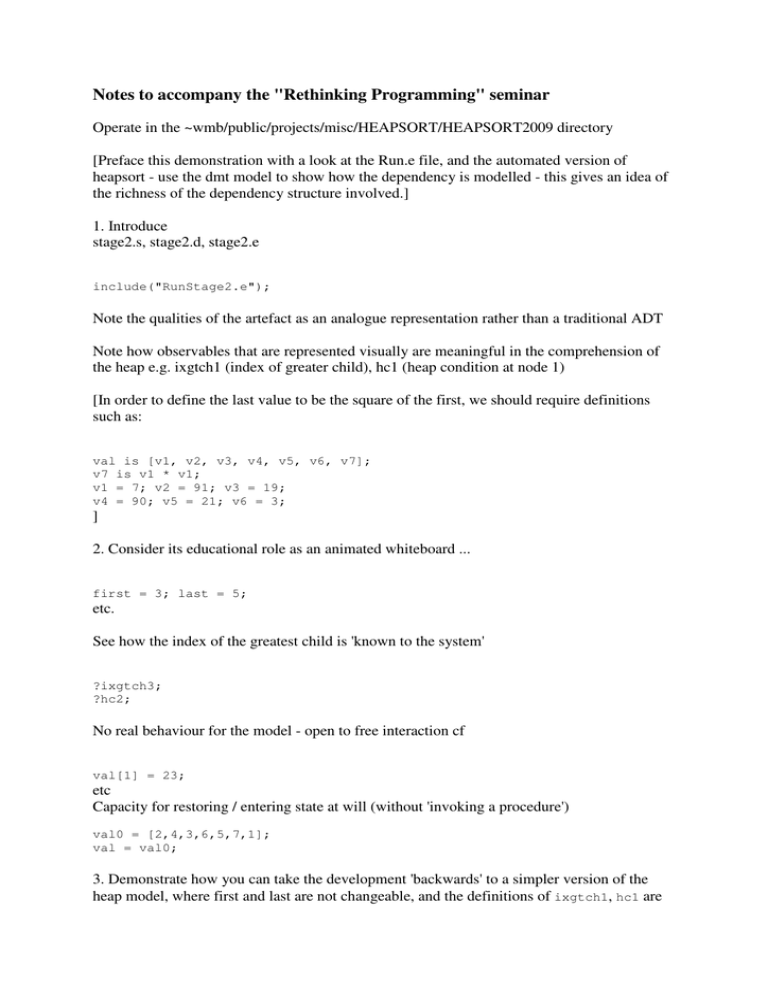
Notes to accompany the "Rethinking Programming" seminar
Operate in the ~wmb/public/projects/misc/HEAPSORT/HEAPSORT2009 directory
[Preface this demonstration with a look at the Run.e file, and the automated version of
heapsort - use the dmt model to show how the dependency is modelled - this gives an idea of
the richness of the dependency structure involved.]
1. Introduce
stage2.s, stage2.d, stage2.e
include("RunStage2.e");
Note the qualities of the artefact as an analogue representation rather than a traditional ADT
Note how observables that are represented visually are meaningful in the comprehension of
the heap e.g. ixgtch1 (index of greater child), hc1 (heap condition at node 1)
[In order to define the last value to be the square of the first, we should require definitions
such as:
val is [v1, v2, v3, v4, v5, v6, v7];
v7 is v1 * v1;
v1 = 7; v2 = 91; v3 = 19;
v4 = 90; v5 = 21; v6 = 3;
]
2. Consider its educational role as an animated whiteboard ...
first = 3; last = 5;
etc.
See how the index of the greatest child is 'known to the system'
?ixgtch3;
?hc2;
No real behaviour for the model - open to free interaction cf
val[1] = 23;
etc
Capacity for restoring / entering state at will (without 'invoking a procedure')
val0 = [2,4,3,6,5,7,1];
val = val0;
3. Demonstrate how you can take the development 'backwards' to a simpler version of the
heap model, where first and last are not changeable, and the definitions of ixgtch1, hc1 are
based on the assumption that all the elements in the array are present in the heap (and are thus
not framed in terms of the conditions inhp1, imhp2, ...).
include("change21");
4. Definition of hc1 and ixgtch1 are now easier to understand - a conceptual stage preparatory
to grasping the general notion of a heap as a segment of an array with a first and last index.
5. Can start to explore effect of actions, such as changing / exchanging values has on the heap
condition at nodes etc. - introducing exc.e to give requisite procedure.
include("exc.e");
6. Can turn this into a GUI style environment for interaction with the heap by introducing the
file change23 (with Model 1 in place).
include("change23");
Now the user can experiment by clicking at nodes.
[Seem to encounter a bug in Scout at this point, whereby the heapwin window isn't sensitive,
despite its specification:
%scout
window heapwin = {
type: DONALD
box: [{0, 100}, {500, 600}]
pict: "Heapview"
bgcolor: white
border: 0
sensitive: ON
};
Can check whether get sensitivity through opening the "Command History" and looking for
mouse button redefinitions. Re-entering this Scout definition seems to fix the problem. WMB
23/11/09]
Learning issues:
## is the user simply responding to the colours of nodes?
c3col is (hc3)?"blue": "red";
## motivates redefinitions:
c3col is (hc3)? BLUE: RED;
BLUE = "blue";
RED is BLUE;
##
etc
## reset via
RED = "red";
## accuracy of clicking (near = 10)
near = 4
## ---> test of skill in use of the mouse
near = 100
near = 1000
Script extension needed for recolouring here is:
c1col
c2col
c3col
c4col
c5col
c6col
c7col
A_l12
A_l13
A_l24
A_l25
A_l36
A_l37
A_c4
A_c5
A_c6
A_c7
is
is
is
is
is
is
is
is
is
is
is
is
is
is
is
is
is
(hc1) ? BLUE : RED;
(hc2) ? BLUE : RED;
(hc3) ? BLUE : RED;
(hc4) ? BLUE : RED;
(hc5) ? BLUE : RED;
(hc6) ? BLUE : RED;
(hc7) ? BLUE : RED;
"color="//((ord12==0)
"color="//((ord13==0)
"color="//((ord24==0)
"color="//((ord25==0)
"color="//((ord36==0)
"color="//((ord37==0)
?
?
?
?
?
?
BLACK:((ord12==
BLACK:((ord13==
BLACK:((ord24==
BLACK:((ord25==
BLACK:((ord36==
BLACK:((ord37==
1)?BLUE:
1)?BLUE:
1)?BLUE:
1)?BLUE:
1)?BLUE:
1)?BLUE:
RED));
RED));
RED));
RED));
RED));
RED));
"outlinecolor="//c4col;
"outlinecolor="//c5col;
"outlinecolor="//c6col;
"outlinecolor="//c7col;
7. Moving to a more constrained behaviour ...
include("change12");
include("change13.2");
include("animate.e");
include("add.e");
Can now click to get animation of heapsort where in principle have observables such as the
phase of heapsort ...
[demonstrate this]
The Is this heapsort? issue ...
The pattern of exchanges is precisely as prescribed in heapsort, but there is no oblivious
behaviour as specified by a procedure (consider how the next index at which to make an
exchange if necessary is determined in trad procedural heapsort). Proof of this ...
first = 4;
last = 7;
next = 0;
Start heapsorting, then intervene to put
val[7] = 8;
say - then continue the 'heapsort' procedure.
Finally: display Rungrattanaubol's extension with the WP precondition spec alongside.
